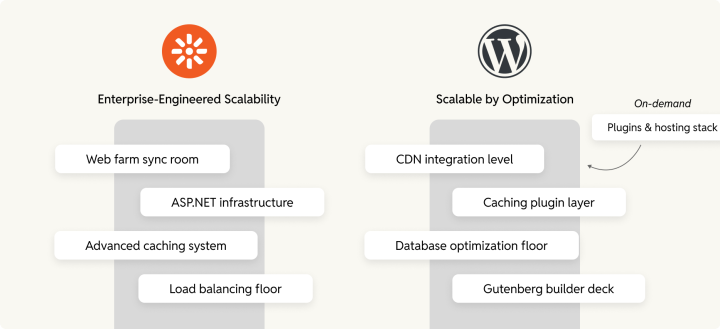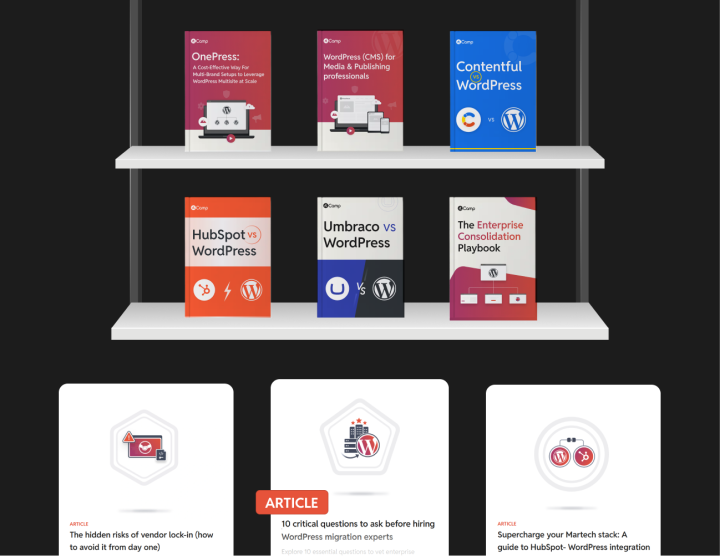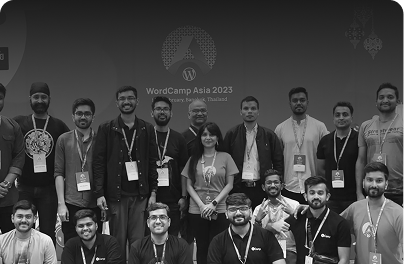Kentico vs WordPress: Upgrades, scalability, and operational considerations
Choosing the right CMS requires a deep understanding of its capabilities. It’s about making a data-driven decision that ensures your website’s growth and success.
Upgrading efforts

In Kentico, migrating from Kentico Xperience 13 (KX13) to Xperience by Kentico (XbyK) or even between Kentico versions requires a lot of effort. Kentico itself highlights three stages of complexity that its users might come across when migrating to Kentico or upgrading levels within the Kentico ecosystem:
- Low: The Kentico Migration Tool, when properly configured, transfers all data directly and accurately into the target XbyK instance.
- Medium: The migration tool can transfer data, but considerable developer effort is required to ensure that the feature functions as it did previously.
- High: The team responsible will need to completely rework this feature in XbyK because it is either significantly different, not supported by the migration tool, or not available as a standard option in XbyK.
In fact, Kentico has marked difficulty levels for lots of its items (pages, media libraries, data protection, contact management, etc.), and things are mostly fairly difficult for complex/customized Kentico setups.
In WordPress, on the other hand, updates are quite straightforward with automatic updates for core software.
For detailed instructions, read this: How to Migrate to a WordPress Site.
Scalability features of Kentico compared to WordPress

Both CMS offer good and dependable scalability features, while WordPress is simpler and cost-effective and can adapt to website traffic by integrating plugins and optimizing efforts to achieve similar scalability. Kentico uses built-in caching mechanism and load balancing to provide consistent performance during peak usage times.
If you’re thinking of scalability, picture this NASA (built with Gutenberg), The New Yorker, BBC and even The White House are all hosted on WordPress, feel free to make assumptions about their audience range. It’s safe to assume that WordPress is stable, scalable, and secure.
WordPress offers a variety of caching and optimization plugins to enhance performance, enabling significant scalability on the right hosting infrastructure. While Kentico is designed for enterprise scale, WordPress can scale effectively for large enterprise sites, especially when optimized properly.
This includes the use of high-quality server hardware and managed hosting solutions, such as WordPress VIP, which offers caching and Content Delivery Network (CDN) integration.
CDN is a good combination to enhance WordPress’s scalability by caching static content closer to you based on your active geographic location. This works positively by reducing load times and improving the overall user experience.
WordPress improves performance, by optimizing the website’s database by using techniques like indexing, and query optimization to pull data faster and improve the site responsiveness on all touchpoints.
Kentico too has several advantages due to its modern licensing options, infrastructure built on ASP.NET technology, automatic synchronization features, advanced caching mechanisms, and of course cloud scalability capabilities.
When deployed in a web farm environment, Kentico offers built-in automatic synchronization of files and in-memory objects across multiple servers. With Automated updates, websites are always in sync and can reflect across all instances. Users do have the authority and the flexibility to scale their operations by paying more.







